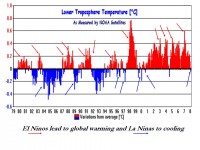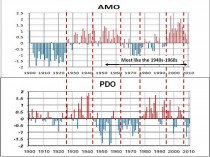By Joseph D’Aleo, CCM
Why the current cooling is likely just the start!
Although, I believe the sun is likely the primary driver for the changes to global climate, the oceans may provide the mechanisms for the changes on year-to-year to multidecadal time scales. In a prior analysis, we had shown how the sun and oceans correlated better with US temperature changes than carbon dioxide over the last century. The oceans had the strongest correlation. In this analysis, we will present evidence for how and why the oceans affect temperatures.
The oceans warm and cool much slower than land for a number of reasons. (1) The sun is able to warm only the thin upper surface of the land directly while it may penetrate many meters into the ocean; (2) The ocean like the air but unlike land is subject to vertical mixing and convective movements; (3) The thermal capacity of the oceans is much higher because the water has roughly four times the specific heat (the amount of heat required to warm a given volume 1 degree Celsius) as most land surfaces. This is why land warms more and much faster than the ocean in the spring and cools more and faster in the fall.
As John Brignell has noted, one consequence of the ocean’s ability to absorb more heat is that when an area of ocean becomes warmer or cooler than usual, it takes much longer for that area to revert to “normal” than it would for a land area. Also because of the huge discrepancy in volumetric thermal capacities, the influence of water on air is very much greater and more immediate than air on water. A change in atmospheric temperatures might take decades to affect the oceans, but the flip of an anomaly of an ocean pool of water has an almost immediate effect on the air. Although ocean temperature anomalies tend to persist for long periods, there are large-scale oscillations or flip-flops that take place on scales of a few years to multiple decades. These oscillations have profound effect on global temperatures. This can be seen with the El Ninos and La Ninas.

See larger image here
In this post, we will look further into the ENSO effects and also show how the longer term multidecadal PDO affects El Nino and La Nina frequency and through that the global temperature tendencies. And we end with a look ahead with changes underway to the sun and ocean.

See larger image here
See full blog here.




